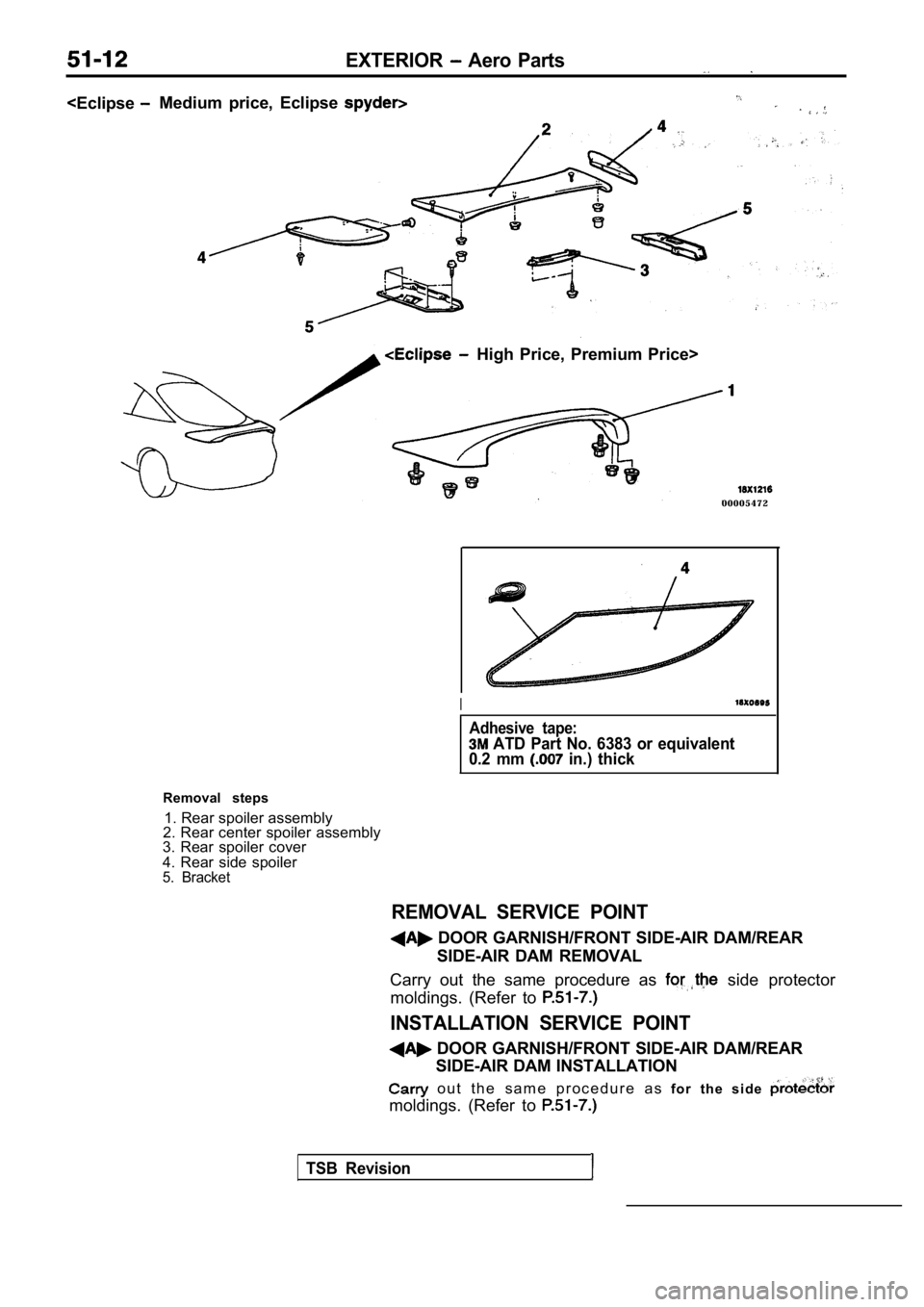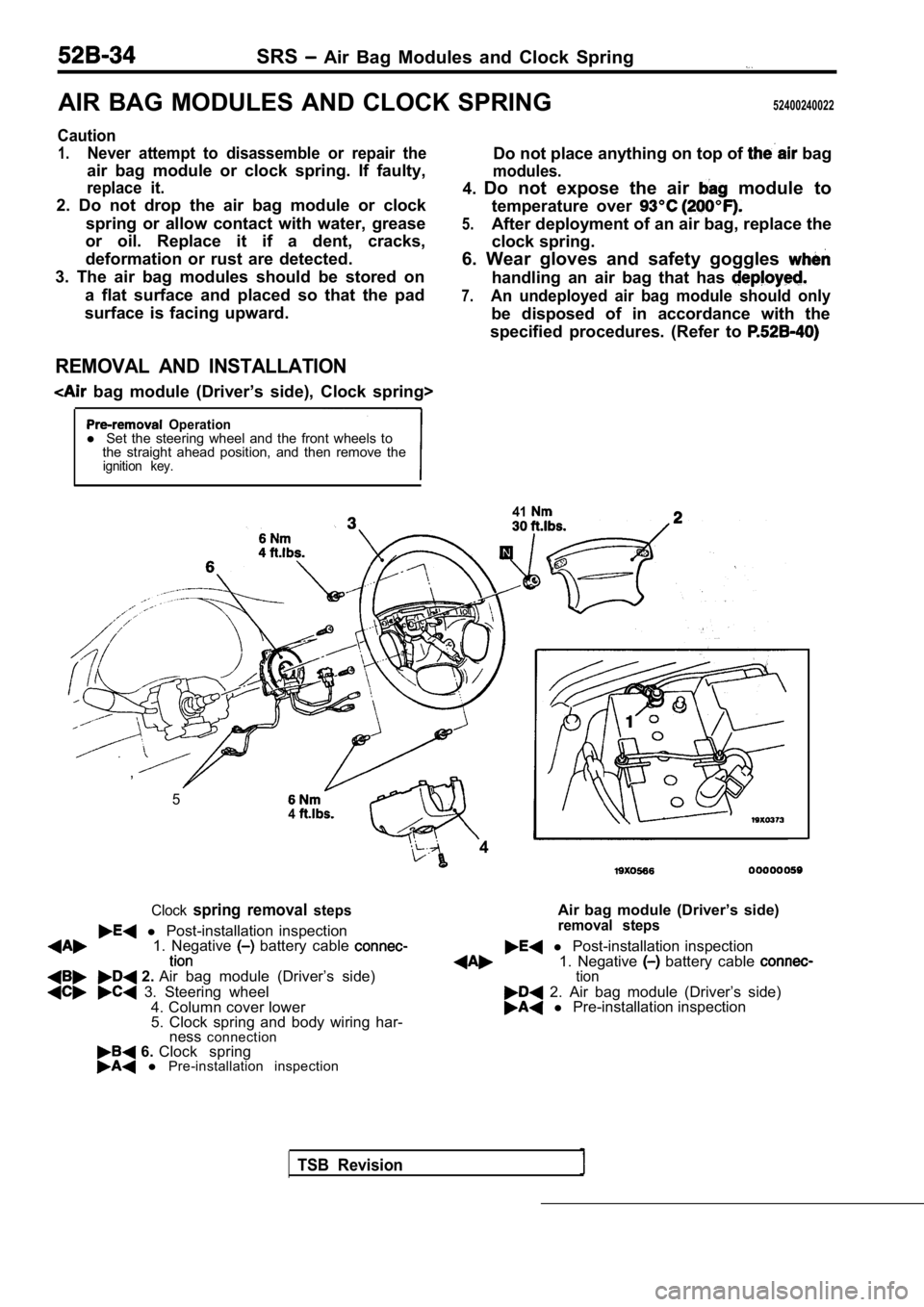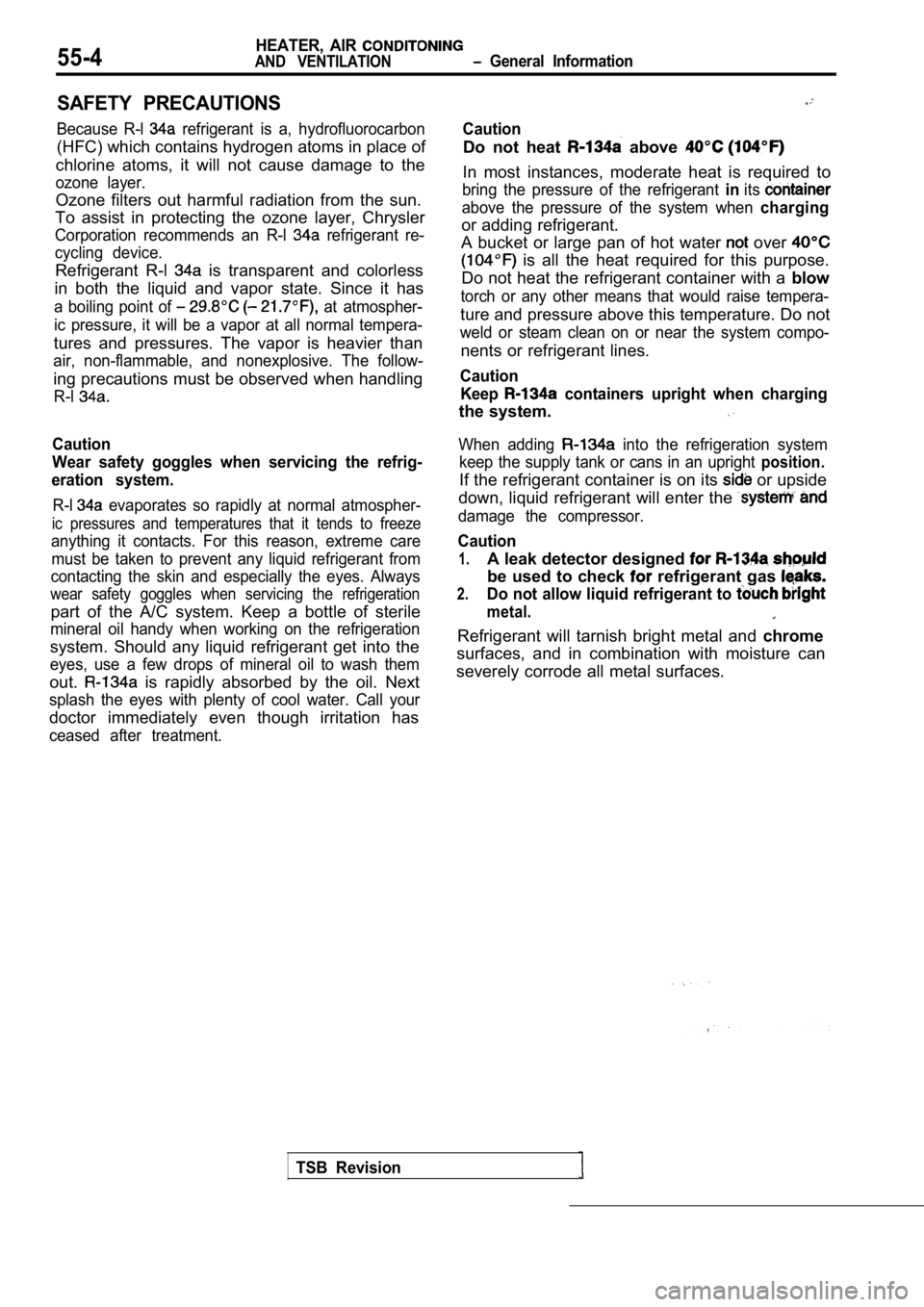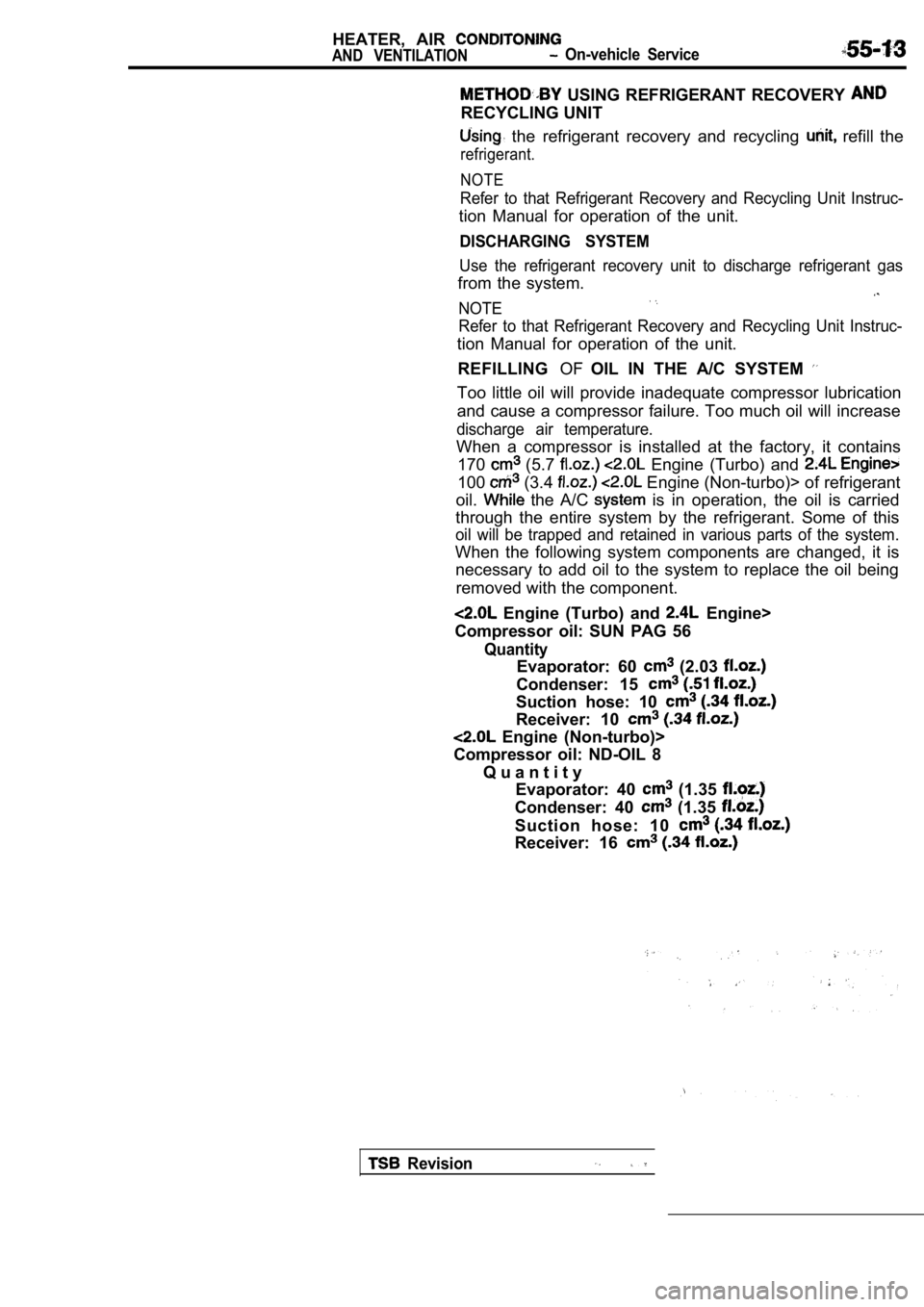1990 MITSUBISHI SPYDER oil
[x] Cancel search: oilPage 1853 of 2103

BODY Windshield. and Window
REMOVAL AND INSTALLATION
Pre-removal and Post-installation Operation
Removal and Installation
l Rear Wiper Arm(Refer to GROUP 51 Rear Wiper and Washer.)l Upper Trim, Lower Trim and Side Trim (Refer to GROUP Trims.)l High-mounted Stop Light without rearspoiler, (Refer to GROUP 54 High-mounted Stop
Light.)
Adhesive tape:
or equivalent
Section C-C24
Section
Section D-D
mm (in.). .
Adhesive:
ATD Part No. Super Fast Urethane and ATD Part No. 8608 Super Fast Urethane prim& equivalent
Removal steps
Harness connector 3. m o l d i n g
2. g l a s s Dual-lock fasteners
TSB Revision
Page 1942 of 2103

EXTERIOR Aero Parts
0 0 0 0 5 4 7 2
Removal steps 1. Rear spoiler assembly
2. Rear center spoiler assembly
3. Rear spoiler cover
4. Rear side spoiler
5. Bracket
REMOVAL SERVICE POINT
I
Adhesive tape:
ATD Part No. 6383 or equivalent
0.2 mm in.) thick
DOOR GARNISH/FRONT SIDE-AIR DAM/REAR
SIDE-AIR DAM REMOVAL
Carry out the same procedure as
side protector
moldings. (Refer to
INSTALLATION SERVICE POINT
DOOR GARNISH/FRONT SIDE-AIR DAM/REAR SIDE-AIR DAM INSTALLATION
o u t t h e s a m e p r o c e d u r e a s f o r t h e s i d e
moldings. (Refer to
TSB Revision
Page 2030 of 2103

SRS Air Bag Modules and Clock Spring
AIR BAG MODULES AND CLOCK SPRING52400240022
Caution
1.Never attempt to disassemble or repair the
air bag module or clock spring. If faulty,
replace it.
2. Do not drop the air bag module or clockspring or allow contact with water, grease
or oil. Replace it if a dent, cracks,
deformation or rust are detected.
3. The air bag modules should be stored on
a flat surface and placed so that the pad
surface is facing upward. Do not place anything on top of
bag
modules.
4.
Do not expose the air module to
temperature over
5.After deployment of an air bag, replace the
clock spring.
6. Wear gloves and safety goggles
handling an air bag that has
7.An undeployed air bag module should only
be disposed of in accordance with the
specified procedures. (Refer to
REMOVAL AND INSTALLATION
bag module (Driver’s side), Clock spring>
Operationl Set the steering wheel and the front wheels to
the straight ahead position, and then remove the
ignition key.
41
1. Negative battery cable l Post-installation inspection
2. Air bag module (Driver’s side) 1. Negative battery cable tion
3. Steering wheel
4. Column cover lower 2. Air bag module (Driver’s side)
5. Clock spring and body wiring har- l Pre-installation inspection
ness connection
6. Clock spring l Pre-installation inspection
TSB Revision
,
54
4
Clockspring removal steps
l Post-installation inspection Air bag module (Driver’s side)removal steps
Page 2040 of 2103

SRS Air Baa Module Procedures
Strong
bag module
At alocation as far away from the air bag as
possible, and from a shielded position, if possible , discon-
nect the two connected wires from each other and co nnect
them to the two terminals of- the battery (removed from
the vehicle) to deploy the air bag.
Caution
1. Before deployment, check carefully to be sure that no one is nearby.
2.The inflator will be quite hot immediately followin g’
deployment, so wait at least 30 minutes to allow
it to cool before attempting. to handle it.
Although not poisonous, do not inhale gas from
air bag deployment. See Deployed Air Bag Module
Disposal Procedures for post-deploy-
ment handling instructions.
3. If the air bag module fails to deploy when the
procedures above are followed, do not go near
the module. Contact the MMSA Tech. Line.
5.Dispose of the air bag module after according
to the Deployed Air Bag Module Disposal Procedures (Refer to
DEPLOYED AIR BAG DISPOSAL
After deployment, the air bag module should be
of in the same manner as any other scrap parts, exc ept
the following points should be carefully noted during disposal.
(1) The inflator will be quite hot immediately foll owing
ment, so wait at least 30 minutes to allow it to co ol before
attempting to handle it.
(2) Do not put water or oil on the air bag after de ployment.
(3) There may be, adhered to the deployed air bag module,
material that could irritate the eyes
skin, so wear
gloves and safety goggles when handling a deployed
air bag module. IF DESPITE THESE PRECAUTIONS,
THE MATERIAL DOES, GET INTO
OR ON
THE SKIN, IMMEDIATELY RINSE THE AFFECTED AREA
WITH A LARGE AMOUNT OF CLEAN WATER. IF ANY
IRRITATION DEVELOPS, SEEK ATTENTION.
(4) Tightly seal the air bag module in a strong pla stic bag
for disposal.
(5) Be sure to always wash your hands after this
operation.
TSB Revision
Page 2044 of 2103

55-4HEATER, AIR
AND VENTILATION General Information
SAFETY PRECAUTIONS
Because R-l refrigerant is a, hydrofluorocarbon
(HFC) which contains hydrogen atoms in place of
chlorine atoms, it will not cause damage to the
ozone layer.
Ozone filters out harmful radiation from the sun.
To assist in protecting the ozone layer, Chrysler
Corporation recommends an R-l refrigerant re-
cycling device.
Refrigerant R-l is transparent and colorless
in both the liquid and vapor state. Since it has
a boiling point of at atmospher-
ic pressure, it will be a vapor at all normal tempe ra-
tures and pressures. The vapor is heavier than
air, non-flammable, and nonexplosive. The follow-
ing precautions must be observed when handling
R-l
Caution
Wear safety goggles when servicing the refrig-
eration system.
R-l evaporates so rapidly at normal atmospher-
ic pressures and temperatures that it tends to free ze
anything it contacts. For this reason, extreme care
must be taken to prevent any liquid refrigerant fro m
contacting the skin and especially the eyes. Always
wear safety goggles when servicing the refrigeratio n
part of the A/C system. Keep a bottle of sterile
mineral oil handy when working on the refrigeration
system. Should any liquid refrigerant get into the
eyes, use a few drops of mineral oil to wash them
out. is rapidly absorbed by the oil. Next
splash the eyes with plenty of cool water. Call your
doctor immediately even though irritation has
ceased after treatment.
Caution
Do not heat above
In most instances, moderate heat is required to
bring the pressure of the refrigerant inits
above the pressure of the system when charging
or adding refrigerant.
A bucket or large pan of hot water
over
is all the heat required for this purpose.
Do not heat the refrigerant container with a blow
torch or any other means that would raise tempera-
ture and pressure above this temperature. Do not
weld or steam clean on or near the system compo-
nents or refrigerant lines.
Caution
Keep
containers upright when charging
the system.
When adding into the refrigeration system
keep the supply tank or cans in an upright
position.
If the refrigerant container is on its or upside
down, liquid refrigerant will enter the
damage the compressor.
Caution
1.A leak detector designed
be used to check refrigerant gas
2.Do not allow liquid refrigerant to
metal.
Refrigerant will tarnish bright metal and chrome
surfaces, and in combination with moisture can
severely corrode all metal surfaces.
TSB Revision
Page 2045 of 2103

HEATER, AIR Service
AND VENTILATION Special Tools
SERVICE SPECIFICATIONS
IStandard value ‘I
speed E n g i n e ( T u r b o ) a n d
EngineII
Engine (Non-turbo)I
up speed
Resistor (for blower motor) LO
100 in Neutral
1.83
MHI 0.31
Revolution pick up sensor standard resistance
Engine (Non-turbo)>
185
[when ambient temperature is
Refrigerant temperature switch ON (continuity) tempe rature
Engine (Turbo) and
Engine>OFF (no continuity) temperature
Approx. or less
Approx. or more
(until the temperature drops to approx.
when OFF)
Air gap (Magnetic clutch) mm (in.)
Engine (Turbo) and
Engine
Engine (Non-turbo)I
LUBRICANTS
ItemsSpecified lubricants Quantity
Each connection of refrigerant line ND-OIL 8 Engine (Non-turbo)>, SUN PAG 56 As required
Engine (Turbo) and Engine>
Lip seal of the compressor ND-OIL 8
Engine (Non-turbo)>As required
Compressor refrigerant unit lubricant SUN PAG 56
lubricant
Engine (Turbo) and Engine>
ND-OIL 8
Engine (Non-turbo)>
SPECIAL TOOLS
ToolTool number and nameSupersession Application
367Armature mounting nut of com-
e S p e c i a l s p a n n e r removal and installation
Engine (Turbo) and
Engine>
386
Pin
TSB Revision
Page 2046 of 2103

HEATER, AIR
AND VENTILATION Troubleshooting
TROUBLESHOOTING
PROCEDURES
Trouble
symptom
When the ignitior
switch is “ON”,
the
does not
operate.
conditioning
does not
when
he air outlet
knob is
noved to the
or
position. Problem cause
compressor clutch relay
is defective
Magnetic clutch is defective
Refrigerant leak or overfilling
of refrigerant
Dual pressure switch is defec-
tive
A/C switch is defective Blower switch is defective
Fin
sensor is defective
Refrigerant temperature switch
is defective
Engine (Tur-
bo) and
Engine>
Automatic compressor-ECM
is defective
Revolution pick up sensor is
defective
Engine (Non-turbo)>
A/C compressor relay is de-
fective
1
Dual pressure switch is defec-
tive
Defroster switch is defective
TSB Revision
Magnetic clutch is defective
Refrigerant leak or overfilling
of refrigerant Remedy
Reference ReferencepagepageEngine
Engine(Non-turbo) (Turbo) Engine
Replace A/C compressor clutch 55-1855-18
relay
Replace the armature plate, rotor55-34
or clutch coil
Replenish the refrigerant, repair
0
the leak or take out some of therefrigerant
Replace the dual pressure switch 55-45
Replace the A/C switch 55-2355-23
Replace the blower switch55-22 55-22
Replace the fin sensor
Replace the refrigerant tempera-
ture switch
Replace the automatic
Replace the revolution pick up
sensor
55-26
Replace A/C compressor clutch55-18
relay
Replace the armature plate, rotor55-34
or clutch coil
Replenish the refrigerant, repair
the leak or take out some of the
refrigerant
Replace the dual pressure switch55-45
the defroster switch55-22 55-22
the blower switch55-225 5 - 2 2
temperature Replace the refrigerant tempera-
is defective
ture switch
compressor-ECU isReplace the automatic 55-26
sor-ECU
pick up sensor is
Replace the revolution pick up
sensor Engine
Page 2053 of 2103

HEATER, AIR
AND VENTILATION On-vehicle Service
USING REFRIGERANT RECOVERY
RECYCLING UNIT
the refrigerant recovery and recycling refill the
refrigerant.
NOTE
Refer to that Refrigerant Recovery and Recycling Unit Instruc-
tion Manual for operation of the unit.
DISCHARGING SYSTEM
Use the refrigerant recovery unit to discharge refrigerant gas
from the system.
NOTE
Refer to that Refrigerant Recovery and Recycling Un it Instruc-
tion Manual for operation of the unit.
REFILLING OFOIL IN THE A/C SYSTEM
Too little oil will provide inadequate compressor l ubrication
and cause a compressor failure. Too much oil will i ncrease
discharge air temperature.
When a compressor is installed at the factory, it c ontains
170
(5.7 Engine (Turbo) and
100 (3.4 Engine (Non-turbo)> of refrigerant
oil.
the A/C is in operation, the oil is carried
through the entire system by the refrigerant. Some of this
oil will be trapped and retained in various parts of the system.
When the following system components are changed, i t is
necessary to add oil to the system to replace the o il being
removed with the component.
Engine (Turbo) and Engine>
Compressor oil: SUN PAG 56
Quantity
Evaporator: 60 (2.03
Condenser: 15
Suction hose: 10
Receiver: 10
Engine (Non-turbo)>
Compressor oil: ND-OIL 8
Q u a n t i t y Evaporator: 40
(1.35
Condenser: 40 (1.35
Suction hose: 10
Receiver: 16
Revision